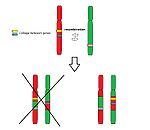Extrachromosomal and Non-Mendelian Inheritance
(Redirected from Non-Mendelian Inheritance)
The laws of inheritance were established in the nineteenth century by an Austrian monk Gregor Mendel, since then we talk about Mendelian inheritance. Over the next years and decades some exceptions, which do not correspond with original ideas, were discovered.
Epigenetic Inheritance[edit | edit source]
Epigenetic influences modify genetic information (gene expression) without changing the primary structure of the DNA (nucleotide sequence). This modification could be changed (reprogrammed) during an individual's life, but it could be also transmitted to the next generation(s) [1].
Methylation[edit | edit source]
Methylation is a type of chemical modification when methyl group binds to DNA basis. This change decides whether a gene will be expressed or not. It goes against the third law of inheritance - law of dominance. Although the inheritance of some diseases seem to be autosomal, it can be transmitted in different ways, depending on which parent you get the genetic information from.
Methylation can sometimes protect its carrier from the outbreak of a disease, but his/her children have higher risk, if they do not have these methyl groups. There are two main diseases, which are influenced by this modification: fragile X syndrome and Huntington disease (E.g. Huntington disease inherited from father has earlier onset than the maternal one.)
Imprinting[edit | edit source]
Imprinting is important for two human diseases - Angelman and Prader-Willi syndromes. More information here.
Extranuclear Inheritance[edit | edit source]
The original Mendelian rules were based just on nuclear DNA, but as it was discovered later, some of the organelles also have their own DNA:
- Mitochondrial DNA - also called mtDNA.
- Chloroplasts in plants.
Extranuclear DNA is also double stranded as the nuclear is and it is located in the nucleoid. Human mtDNA consists of 17 000 bp, which code 13 genes important for oxidative phosphorylation. The maternal type of inheritance is characterized by strict transmition of mtDNA from mother to offspring. It is very important in the origin of mitochondrial diseases - e.g. Leber´s hereditary optic neuropathy, Kearns-Sayre disease. Mitochondrial diseases are chronical and degenerative and affect mainly: muscles, brain, kidneys or glands.
Genetic Linkage[edit | edit source]
Some genes do not assort independently, because they are located on the same chromosome and there is a linkage between them, so they have to be transfered together. More information.
Allelic Interaction[edit | edit source]
Codominant inheritance means that there are two alleles and both of them have their patterns in the offspring. Normally the dominant one overpowers the recessive one, but not in this case. E.g. blood ABO system, where allele A and B have the same importance.
Semi-dominance occurs when a third phenotype is produced, different from the maternal and paternal phenotypes. The new phenotype exhibits a combination, or mixture, of the maternal and paternal phenotypes. One phenotype is not completely dominant over the other, it is semi-dominant. An example of of this is flower color in tulips. A white tulip crossed with a red tulip will produce a pink tulip.
Penetrance[edit | edit source]
The frequency of expression of an allele, which can be found in the genotype. E.g. if you have 10 children and 6 of them have 21 fingers, the penetrance of polydactyly is 6/10 - it is 60%.
Not all phenotypes that are expressed are manifested to the same degree. For polydactyly, an extra digit may occur on one or more appendages, and the digit can be full size or just a stub. Therefore, when the P allele is present it expresses variable expressivity.
Gonosomal Inheritance[edit | edit source]
X-linked disorders affect usually only males (males are hemizygotes since they have only one X chromosome), because females are heterozygous carriers. If a female has one faulty X chromosome and the second one is in order, she does not suffer from all of the symptoms. This can be later changed by an inactivation of X chromosome.
X-linked diseases are: Duchenne and Becker muscular dystrophy, Hemophilia A and B, diabetes insipidus, fragile X chromosome syndrome
Links[edit | edit source]
Related articles[edit | edit source]
External links[edit | edit source]
References[edit | edit source]
- ↑ HALUSKOVÁ,. Epigenetic studies in human diseases. Folia Biol Praha [online]. 2010, vol. 56, no. 3, p. 83-96, Available from <http://www.ncbi.nlm.nih.gov/pubmed/20653993>. ISSN 0015-5500.
Bibliography[edit | edit source]
- KUMAR,, et al. Robbins Basic Pathology. 8th edition. 2007. ISBN 978-0-8089-2366-4.



